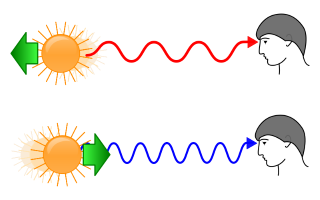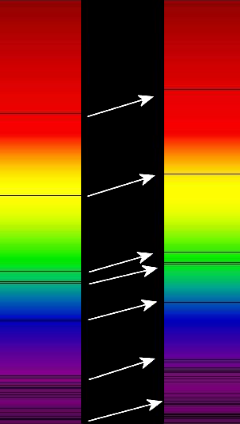One of the key benefits from the ‘fingerprint’ spectra of hydrogen and other elements, isotopes and ions is for calculating and understanding redshifts.
Redshift is the stretching of the wavelengths of light due to an emitting object (perhaps a star or galaxy) moving away from the observer (or the observer’s detector).
- The term comes from the visible light spectrum (see image below) where all of the redshifted light moves away from the blue end of the spectrum towards the red end.
- A similar term, blueshift, is used for emitting objects moving towards the observer.
The effect of redshift is similar to that of a Doppler shift in sound waves.
By measuring how far the pattern for hydrogen and other elements shifts towards the red end of the spectrum, students and scientists can calculate the speed of distant stars and galaxies.
The formula for calculating the speed of a star using redshift is the following: v/c = ( lambda / lambda_0 ) - 1 where v is the speed of the star, c is the speed of light, lambda is the wavelength of the absorption line in the star’s spectrum and lambda_0 is the wavelength of the same absorption line when measured in a science lab on Earth.
Galaxies have the spectra of many billions of stars all added together, so they also have the fingerprints of atomic spectra. In the same way as for stars, the speed of distant galaxies can be found by measuring their redshifted spectral lines.
Edwin Hubble used the redshifts of many galaxy clusters to first discover that the Universe is expanding, creating even more space between galaxies each day.
- Hubble was able to show that galaxies with a larger redshift, which means a faster velocity away from the Milky Way, were also farther away in distance. He found that the velocities and distances of galaxies were related by a simple formula, v = H_0 * d, where v is the velocity of the galaxy, H_0 is the Hubble constant, and d is the distance to the galaxy.
- Hubble interpreted this relation as an expanding Universe, as if the very fabric of space was stretching with time, carrying the galaxies along for the ride. More distant galaxies have a lot of space between them and the Milky Way, so that as space stretches they appear to move away at high velocities.
- More recently, scientists have discovered that the Universe expansion is accelerating (but very gradually). This means that every day the galaxies are also moving apart faster than the day before. Many billions of years from now, we may not be able to see any galaxies apart from our closest neighbors.
The consistent patterns observed in spectra of elements, isotopes and ions from the entire observable Universe strengthens our assumption of the Universal nature of physics. This confidence only extends to the part of the Universe we can see.


